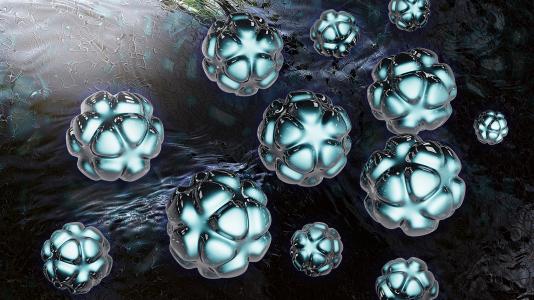
ARGONNE, Ill. – Scientists at the U.S. Department of Energy’s Argonne National Laboratory have added a new weapon to oncologists’ arsenal of anti-cancer therapies.
By combining magnetic nanoparticles with one of the most common and effective chemotherapy drugs, Argonne researchers have created a way to deliver anti-cancer drugs directly into the nucleus of cancer cells.
Researchers at Argonne’s Center for Nanoscale Materials and oncologists at the University of Chicago created nano-sized bubbles, or “micelles,” that contained two ingredients at their centers: magnetic nanoparticles of iron oxide and cisplatin, a conventional chemotherapy drug also known as “the penicillin of cancer.”
Cisplatin works by directly blocking DNA replication within the cancer cell. However, in order to work, the cisplatin has to make it from the bloodstream through the somewhat rigid barrier of the cell membrane.
“When someone is given a dose of chemotherapy, typically much of the drug doesn’t actually make it into the cancer cells. In addition, some cancer patients are sensitive to this drug due to impaired kidney function,” said oncologist Ezra Cohen, an author of the study. “This new method gives a way of delivering the dose of therapeutic cargo much more directly, which will enable us to have the same overall effect with a lower total dose, reducing the unpleasant and dangerous side effects of chemotherapy.”
“This technique could potentially allow us to increase the proportion of cisplatin in cancer cells by a hundredfold, making it that much more effective a chemotherapeutic agent,” he added.
Like the membranes of cancer cells themselves, the micelles are made up of a polymer material whose outer surfaces are hydrophilic, which means they are attracted to water, while the inner parts are hydrophobic, repelling water. “In addition, the surface of micelles can be equipped with targeting molecules capable of recognizing malignancy,” said Argonne nanoscientist Elena Rozhkova, lead author of the study.
Rozhkova and her colleagues still needed a way to get the cisplatin into the nucleus of the cancer cell after the micelle had attached to it. To do so, they also encapsulated iron oxide nanoparticles within the micelle along with the cisplatin. These nanoparticles served as tiny “heaters” that were turned on by an applied magnetic field, which caused the micelle container to collapse and release the cisplatin.
This was not the first time scientists had used applied nanomagnetic heat sources as a way to attack cancer cells, but the more targeted approach of the micelles allowed the researchers to use a much lower amount of heat and much less magnetic material, thereby risking less damage to healthy cells.
In order to see the action of the nanoparticles and cisplatin as the micelle collapsed, the researchers used the Hard X-Ray Nanoprobe at Argonne’s Advanced Photon Source. “Normally, it’s difficult to see how cisplatin is delivered into organelles like the nucleus, but with this technology we can see simultaneously how the drug delivery happens, how the nanoparticles interact with the cell’s membrane and the cell’s response,” said Argonne nanoscientist Volker Rose.
The study, entitled “Efficient cisplatin pro-drug delivery visualized with sub-100 nm resolution: interfacing engineered thermosensitive magnetomicelles with a living system,” appeared online in the June 6 issue of Advanced Materials Interfaces.
The materials characterization and synthesis work was performed at the Center for Nanoscale Materials and the Advanced Photon Source, both DOE Office of Science User Facilities. The medical aspects of the research, including animal studies, were supported by the University of Chicago.
Argonne National Laboratory seeks solutions to pressing national problems in science and technology. The nation’s first national laboratory, Argonne conducts leading-edge basic and applied scientific research in virtually every scientific discipline. Argonne researchers work closely with researchers from hundreds of companies, universities, and federal, state and municipal agencies to help them solve their specific problems, advance America’s scientific leadership and prepare the nation for a better future. With employees from more than 60 nations, Argonne is managed by UChicago Argonne, LLC for the U.S. Department of Energy’s Office of Science. For more visit www.anl.gov. DOE’s Office of Science is the single largest supporter of basic research in the physical sciences in the United States, and is working to address some of the most pressing challenges of our time. For more information, please visit science.energy.gov.
The Center for Nanoscale Materials at Argonne National Laboratory is one of the five DOE Nanoscale Science Research Centers (NSRCs), premier national user facilities for interdisciplinary research at the nanoscale, supported by the DOE Office of Science. Together the NSRCs comprise a suite of complementary facilities that provide researchers with state-of-the-art capabilities to fabricate, process, characterize and model nanoscale materials, and constitute the largest infrastructure investment of the National Nanotechnology Initiative. The NSRCs are located at DOE’s Argonne, Brookhaven, Lawrence Berkeley, Oak Ridge and Sandia and Los Alamos National Laboratories. For more information about the DOE NSRCs, please visit the Office of Science website.
The Advanced Photon Source at Argonne National Laboratory is one of five national synchrotron radiation light sources supported by the U.S. Department of Energy’s Office of Science to carry out applied and basic research to understand, predict, and ultimately control matter and energy at the electronic, atomic, and molecular levels, provide the foundations for new energy technologies, and support DOE missions in energy, environment, and national security. To learn more about the Office of Science user facilities, go to https://www.energy.gov/science/science-innovation/office-science-user-facilities.